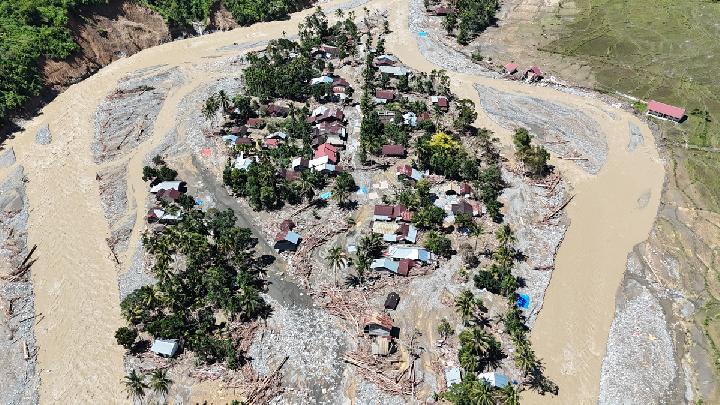TEMPO.CO, Jakarta - Earth boasts an incredibly diverse landscape, where every bend experiences its own unique climate. While Columbia stands out as the wettest country, Egypt, Libya, and Saudi Arabia hold the distinction of being the driest countries in the world.
According to the latest data from WorldBank, the nations that share this exceptionally arid climate have one thing in common: they lie across the Sahara and Arabian Peninsula, regions dominated by persistent subtropical high-pressure systems and intense year-round sunshine, leaving little room for clouds or rainfall to form.
So what exactly makes these places hold the title as the world's driest countries? A closer look reveals just how geography and climate systems work hand in hand to shape such extreme environments. Read on to uncover the reasons.
1. Egypt - 18 (mm/yr)
With an average annual precipitation of just 18 mm, Egypt leads the pack of the world’s driest countries. Located within the eastern Sahara, the country experiences extreme heat, long dry summers, and almost no rainfall. And while the Nile brings vital water to the country, the hot Khamsin winds still reinforce Egypt’s intense dryness.
2. Libya - 56 (mm/yr)
Similar to Egypt, Libya’s extreme dryness also stems from its location within the Sahara Desert. Even more striking, almost the entire country is covered by desert, creating hyper-arid conditions. Rainfall is rare to virtually nonexistent, and Libya routinely experiences scorching summers, with temperatures often hovering between 35°C and 41°C.
3. Saudi Arabia - 59 (mm/yr)
Situated on the vast Arabian Peninsula, Saudi Arabia receives an average of just 59 mm of rainfall annually, most of which occurs between November and April. The country’s arid landscape is dominated by deserts like the Rub’ al Khali, one of the world’s most massive. With scorching daytime temperatures, moisture quickly evaporates, making rainfall a rare event.
4. Qatar - 74 (mm/yr)
While Qatar enjoys a relatively stable climate, its flat terrain leaves it exposed to an intensely dry desert environment. Characterized by soaring heat and high humidity, rainfall and snow are almost unheard of in this Gulf nation. The dry southerly winds that blow across the peninsula throughout the year further sustain its arid conditions.
5. United Arab Emirates - 78 (mm/yr)
The UAE receives around 78 mm of rain annually, placing it among the driest countries on Earth. While coastal cities like Dubai and Abu Dhabi occasionally experience light winter rain, most of the nation is dominated by arid desert plains and rugged mountains. As highlighted by Expatica, dust storms are also a common occurrence, particularly during the transition from winter to spring.
6. Bahrain - 83 (mm/yr)
An island nation in the Persian Gulf, Bahrain endures a hot, arid desert climate with minimal rainfall that typically falls during the winter months. And as it’s surrounded by warm gulf waters and desert landmasses, Bahrain’s atmosphere rarely allows for sustained cloud formation or precipitation.
7. Algeria - 89 (mm/yr)
Algeria’s dryness is largely attributed to its vast territory lying within the subtropical Sahara region. Temperatures often soar between 40°C and 46°C, with some areas recording above 50°C during peak summer. The country’s extreme heat is further intensified by strong desert winds
8. Mauritania - 92 (mm/yr)
Located within the Sahara’s western flank, Mauritania only … annual rainfall of 92 mm. Though rain showers may occur between July and September, prolonged droughts remain common, as shaped by dry trade winds and high pressure zones.
9. Jordan - 111 (mm/yr)
In Jordan, rainfall averages around 111 mm per year, with most precipitation occurring during the winter months. The country’s dry climate is influenced by the Arabian Desert and the Syrian steppe, creating stark contrasts between its fertile north and its arid south.
10. Kuwait - 121 (mm/yr)
Rounding out the list is Kuwait, of which its hot desert climate brings extremely high summer temperatures, often surpassing 45 °C. Occasional winter showers, between November and April, offer brief relief, but prolonged dry spells and dust storms remain a defining feature of Kuwait’s environment.
While these countries differ in culture and landscape, they share one defining trait: an exceptionally arid climate shaped by geography and atmospheric conditions.
Whether in Africa or the Arabian Peninsula, each demonstrates how life continues to thrive even in the planet’s harshest and driest environments. For that, a stark contrast is seen through the rainiest countries in the world.
Editor’s Choice: 8 Countries Without Army That Are Safe for Vacation
Click here to get the latest news updates from Tempo on Google News

















































